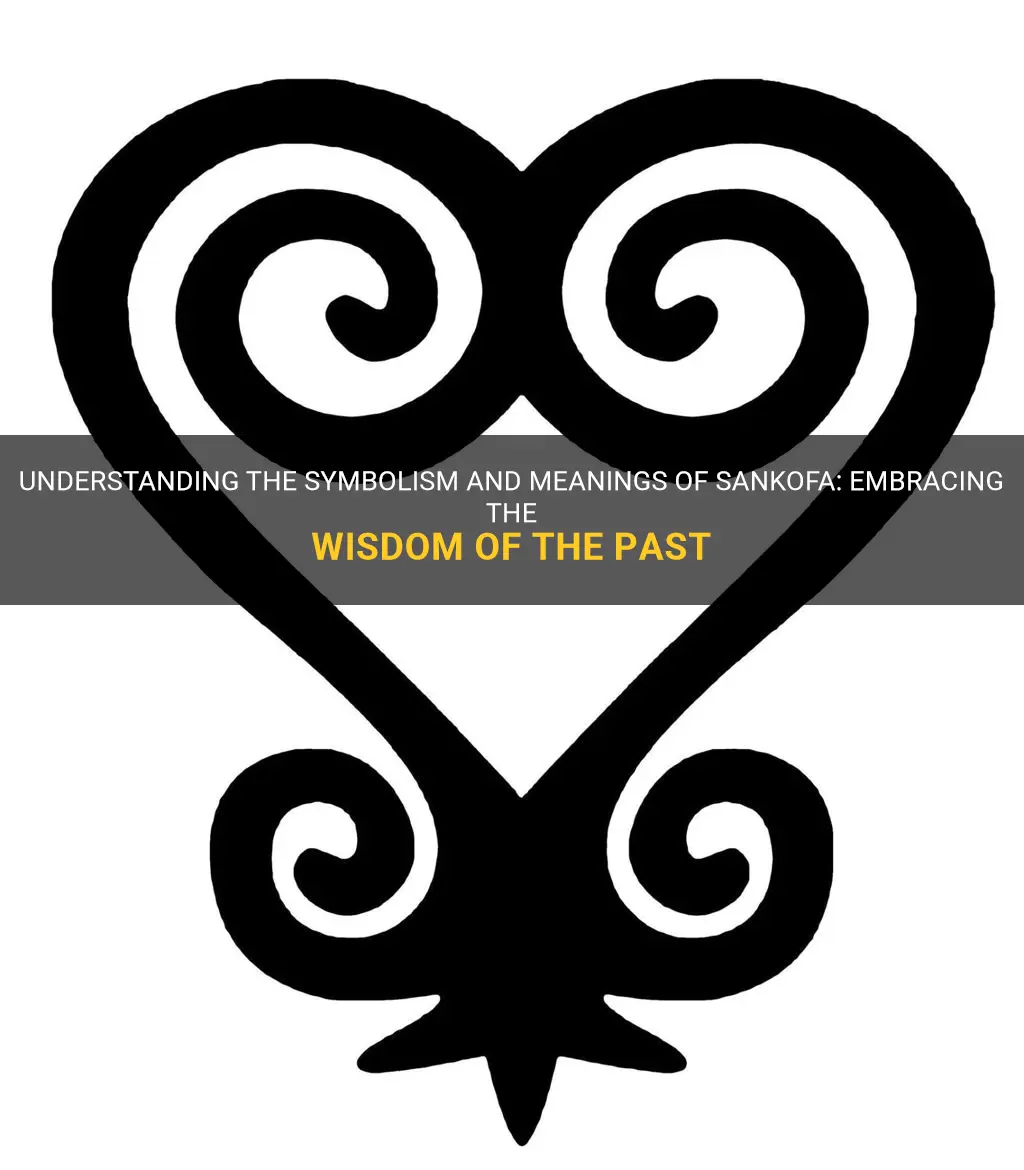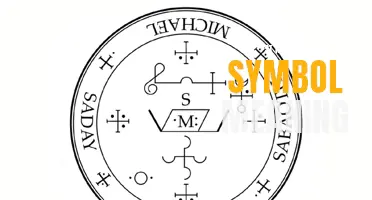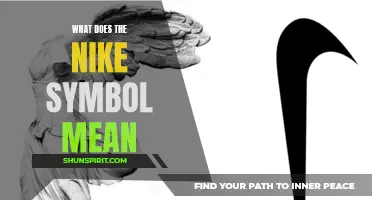
Sankofa is a powerful symbol originating from the Akan people of West Africa that embodies the idea of going back to the past to move forward. Through its depiction of a bird with its head turned backwards while its feet move forward, Sankofa symbolizes the quest for knowledge and understanding of one's heritage, as well as the importance of learning from past experiences to create a better future. It encourages individuals to embrace their roots, celebrate their cultural identity, and recognize the wisdom and lessons of their ancestors. This ancient symbol serves as a poignant reminder of the interconnection between the past, present, and future, and the significance of preserving and passing on heritage and traditions.
What You'll Learn
- What are the key symbols used in the Sankofa tradition and what do they represent?
- How do the symbols of the Sankofa tradition relate to concepts of African heritage and history?
- Can you provide a detailed explanation of the meaning behind the Sankofa bird symbol?
- Are there any specific rituals or ceremonies associated with the Sankofa symbols and meanings?
- How have the Sankofa symbols and meanings been incorporated into contemporary African and African diaspora cultures?

What are the key symbols used in the Sankofa tradition and what do they represent?
The Sankofa tradition is an ancient African concept that emphasizes the importance of learning from the past in order to move forward. It is symbolized by a mythical bird that is depicted as looking backward while moving forward, reflecting the idea of revisiting and retrieving valuable knowledge from history. This tradition has strong roots in the Akan culture of Ghana and has become a prominent symbol within African diaspora communities around the world.
There are several key symbols associated with the Sankofa tradition, each representing a different aspect of the concept. These symbols serve as powerful reminders of the importance of learning from the past and incorporating this knowledge into our present actions.
- Sankofa Bird: The Sankofa bird is the most recognizable symbol of the tradition. It is portrayed as a bird with its head turned backward and its feet facing forward. This visual representation encapsulates the essence of Sankofa, reminding individuals to look back to their roots and heritage while moving forward in life. The bird is often depicted with an egg in its mouth, symbolizing the potential for growth and new beginnings that come from learning from the past.
- Sankofa Heart: The Sankofa heart is a variation of the Sankofa bird symbol. It combines the image of a heart with the head and feet of the bird. This symbol emphasizes the role of love and emotions in the process of learning from the past. It represents the idea that we must approach the lessons of history with an open heart and a willingness to embrace the wisdom and experiences of our ancestors.
- Sankofa Adinkra Symbol: The Sankofa symbol is also depicted as an Adinkra symbol, which is a traditional Akan symbol system. In this form, Sankofa is represented as a stylized heart with a curving neck reaching back to retrieve an egg. This symbol is often used in textiles, pottery, and other artistic forms. It signifies the importance of reclaiming and reviving traditional African knowledge and practices.
- Ankh: The Ankh symbol is an ancient Egyptian symbol that is often associated with the Sankofa tradition. It represents life and eternal existence. It is often used in conjunction with the Sankofa bird or heart symbols to represent the continuation of life and the importance of preserving the wisdom and knowledge of the past.
These symbols are not only visual representations of the Sankofa tradition but also serve as reminders and catalysts for personal growth and cultural revitalization. They encourage individuals to explore and embrace their history and heritage, recognizing that the past holds valuable lessons that can inform and guide our present actions. By drawing upon the wisdom of our ancestors, we can create a better future for ourselves and our communities.
Cracking the Code: Deciphering Grindr Symbols and Their Meanings
You may want to see also

How do the symbols of the Sankofa tradition relate to concepts of African heritage and history?
The Sankofa tradition is an important symbol in African culture that represents the idea of reaching back to one's past in order to move forward. The word "Sankofa" comes from the Akan language of Ghana, and it translates to "go back and fetch it" or "return and get it." This concept is often depicted through the use of various symbols, such as a bird with its head turned backward and an egg or heart-shaped symbol.
The bird in the Sankofa symbol is often depicted with its head turned backward, while its feet are moving forward. This symbolizes the importance of looking back at one's heritage and history in order to move forward in life. The bird represents the idea that one must not forget their past or where they come from, as it serves as a foundation for growth and progress. By understanding and embracing our history, we can learn from the mistakes and successes of those who came before us.
Another symbol often associated with the Sankofa tradition is an egg or heart-shaped symbol. This symbolizes the importance of nurturing and taking care of one's heritage. It represents the idea that our culture and traditions are fragile and must be protected and preserved for future generations. Just as an egg contains the potential for new life, our heritage holds the potential for a vibrant and rich future if it is nurtured and cherished.
The symbols of the Sankofa tradition are deeply intertwined with concepts of African heritage and history. They remind us that our past shapes us and influences our present and future. By embracing our history and culture, we can celebrate our unique identity and contribute to the continued growth and development of our community.
One way in which the symbols of the Sankofa tradition relate to African heritage and history is by reminding us of the importance of oral tradition and storytelling. In many African cultures, history and knowledge are passed down through oral tradition, with stories and lessons being shared from one generation to the next. The Sankofa symbol encourages us to listen to and learn from the stories of our ancestors, as they hold valuable wisdom and insight. Just as the bird in the Sankofa symbol looks backward to retrieve something, we too must look back to our oral traditions to retrieve the knowledge and wisdom of our ancestors.
Additionally, the Sankofa symbols relate to the concept of the African diaspora and the importance of reconnecting with our roots. The transatlantic slave trade forced millions of Africans to leave their homeland and be dispersed across the Americas, Europe, and other parts of the world. The Sankofa symbol serves as a reminder for those in the diaspora to rediscover and reconnect with their African heritage. It embodies the idea that no matter how far we may have been physically separated from our roots, we can always reach back and reclaim our cultural heritage.
In conclusion, the symbols of the Sankofa tradition are powerful representations of African heritage and history. They remind us of the importance of looking back at our past, nurturing our heritage, and embracing our roots. By incorporating these symbols into our lives, we can honor our ancestors, learn from their experiences, and contribute to the ongoing preservation and celebration of African culture.
Decoding the Symbolism Behind Swords: Unveiling the Deeper Meaning
You may want to see also

Can you provide a detailed explanation of the meaning behind the Sankofa bird symbol?
The Sankofa bird symbol is an important and powerful symbol in African culture, particularly in the Akan tribe of Ghana. The word "Sankofa" comes from the Akan language and can be translated as "go back and fetch it" or "return and get it." This symbolizes the importance of learning from the past and using that knowledge to move forward.
The Sankofa bird is typically depicted as a mythical bird with its feet facing forward and its head turned backward, looking over its shoulder. This posture represents the idea of looking back into the past while moving forward into the future. The bird carries an egg in its beak, symbolizing the knowledge and wisdom gained from the past.
The Sankofa bird is often used to represent the importance of learning from history, both as individuals and as a community. It encourages people to reflect on and learn from their past experiences, mistakes, and successes. By doing so, individuals and communities can gain valuable insights and wisdom, which can guide their decisions and actions in the present and future.
The symbol also emphasizes the idea of cultural and historical continuity. In African culture, the past is seen as an integral part of the present and future. By honoring and embracing their cultural heritage, individuals and communities can maintain a sense of identity and strengthen their connections to their roots. The Sankofa bird serves as a reminder that the past should not be forgotten or dismissed, but rather embraced and learned from.
The Sankofa bird is often used in African art, jewelry, and clothing to represent these ideas. It can be seen in various forms, such as sculptures, paintings, and fabric prints. It has also become a popular symbol in the African diaspora, representing the importance of cultural preservation and self-discovery.
Overall, the Sankofa bird symbolizes the idea of looking back to move forward. It encourages individuals and communities to learn from their past, embrace their cultural heritage, and use that knowledge and wisdom to shape a better future. It serves as a powerful reminder of the importance of history and is a symbol of strength, resilience, and self-improvement.
Understanding Color Symbolism: A Comprehensive Koi Fish Color Meaning Chart
You may want to see also

Are there any specific rituals or ceremonies associated with the Sankofa symbols and meanings?
Sankofa, a prominent symbol in Ghanaian culture, represents the importance of learning from the past in order to build a successful future. While there aren't any specific rituals or ceremonies associated with Sankofa, its symbolism is deeply ingrained in various aspects of Ghanaian life.
The Sankofa symbol consists of a bird with its head turned backward and its feet moving forward. This imagery is a reminder to look back at one's roots, history, and ancestors to gain wisdom and guidance for the future. It encourages individuals to explore and embrace their cultural heritage.
In Ghana, Sankofa is often used in the form of fabric prints, sculptures, jewelry, and artwork. It is a visual representation of the wisdom that can be gained from reflecting on the past and incorporating it into one's present and future actions.
While there may not be specific rituals or ceremonies associated with Sankofa, its symbolism is often incorporated into various traditional Ghanaian ceremonies. For example, during funeral rites, the Sankofa symbol might be used to remind mourners of the importance of honoring and learning from the lives of the deceased.
Additionally, Sankofa is sometimes included in educational settings. Schools may incorporate the Sankofa symbol into their curriculum to teach students about the importance of valuing and understanding their cultural heritage. This can involve storytelling, discussions, and activities centered around the essence of the symbol.
Furthermore, Sankofa can be seen as a personal journey or practice. Individuals may use the symbol as a reminder to reflect on their past experiences, learn from their mistakes, and carry forward the wisdom gained. This introspective aspect of Sankofa is a powerful tool for personal growth and development.
While specific rituals or ceremonies may not be associated with Sankofa, its symbolism is deeply rooted in Ghanaian culture. It serves as a call to individuals and communities to remember their history, learn from it, and use that knowledge to shape a brighter future. Whether in artwork, traditional ceremonies, education, or personal reflection, Sankofa plays a significant role in shaping the cultural identity of Ghana.
The Meaning and Significance of the Sister Symbol: A Guide
You may want to see also

How have the Sankofa symbols and meanings been incorporated into contemporary African and African diaspora cultures?
The Sankofa symbol holds significant cultural and historical value for African and African diaspora communities. Derived from the Akan language in Ghana, Sankofa literally means "go back and fetch it" and is represented by a bird with its head turned backward, reaching for an egg on its back. This symbol encapsulates the idea of learning from the past to build a better future.
In contemporary African and African diaspora cultures, the Sankofa symbol and its meanings have been incorporated in various ways, including art, fashion, literature, and activism. One prominent way it is represented is through visual art, where the symbol is often depicted in paintings, sculptures, and other forms. These artworks use Sankofa to convey messages of preserving traditional knowledge, honoring ancestors, and reconnecting with African roots.
The Sankofa symbol can also be found in fashion, particularly in African-inspired clothing and accessories. Designs featuring the Sankofa bird and eggs are popular, as they serve as a reminder to cherish one's heritage and embrace the wisdom and experiences of the past. Many African fashion designers incorporate Sankofa in their collections as a way to celebrate African identity and promote cultural pride.
Literature is another avenue through which the Sankofa symbol and its meanings have been incorporated into contemporary African and African diaspora cultures. Many authors draw inspiration from the symbol to explore themes such as identity, history, and the African diaspora experience. In novels, poems, and other forms of literature, the Sankofa symbol serves as a powerful metaphor for the importance of acknowledging and learning from one's ancestral roots.
Furthermore, the Sankofa symbol has been embraced by activists and social justice movements. It is often used as a rallying symbol for African descendants striving for justice, equality, and empowerment. The concept of going back to the past to reclaim lost heritage and knowledge is particularly relevant to the struggles faced by African and African diaspora communities, as they continue to fight against oppression and reclaim their narratives.
In addition to its artistic and activist representations, the Sankofa symbol is also integrated into everyday life. Many African communities incorporate the Sankofa concept into their educational systems and rituals. By teaching the younger generations about their history and traditions, the Sankofa symbol becomes a tool for cultural preservation and continuity.
Overall, the Sankofa symbol and its meanings have become an integral part of contemporary African and African diaspora cultures. Through its incorporation in art, fashion, literature, activism, and everyday life, the symbol serves as a powerful reminder of the importance of recognizing and honoring one's roots. It encourages a sense of collective memory, resilience, and cultural pride, making it a symbol that continues to resonate with individuals and communities alike.
The Meaning Behind the Empathy Symbol: Understanding the Power of Compassion
You may want to see also
Frequently asked questions
The Sankofa symbol represents the idea of going back to fetch what has been lost or forgotten. It encourages individuals to reflect on the past in order to move forward and make positive changes in the present and future.
The Sankofa symbol originates from the Akan people of Ghana in West Africa. It is a popular symbol used in various aspects of Akan culture, including art, clothing, and jewelry.
The Sankofa symbol is often depicted as a bird with its head turned backward, while its feet face forward. This visual representation represents the idea of reflecting on the past while moving forward with knowledge and wisdom gained from previous experiences.
In African culture, the Sankofa symbol holds a deep spiritual and cultural significance. It symbolizes the importance of learning from history and ancestors, and the need to preserve traditions and values for future generations.
The Sankofa symbol can be applied in everyday life by reminding individuals to value and learn from their past experiences. It encourages personal growth by encouraging reflection, self-awareness, and taking action based on the wisdom gained from the past.







